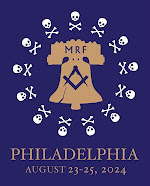UPDATE: On the eve of the opening of the Ancient and Accepted Scottish Rite Southern Jurisdiction’s Biennial Session, vandals splashed red paint onto the Albert Pike statue. WRC-TV, the Washington NBC affiliate, reports:
 |
| Courtesy WRC-TV |
 |
| Courtesy dcist.com |
Today dcist.com reports rallies Sunday and Monday nights at the statue, located at the corner of Third and D streets NW in the Federal City, brought together activists and city officials to renew calls from a generation ago for the removal of the monument because it memorializes a general in the army of the Confederate States of America during the U.S. Civil War. It is the only statue in Washington dedicated to a Confederate figure, but it is Pike the Freemason, not Pike the general, that is commemorated by the 11-foot bronze.
Sculptor Gaetano Trentanove executed the work, creating what National Parks Service records say is Albert Pike:
“...in civilian dress and presented as a Masonic leader rather than a military man. Pike stands 11 feet tall upon a high granite pedestal. Below his feet about halfway down the west face of the pedestal, sitting on a ledge, is the allegorical Goddess of Masonry, holding the banner of the Scottish Rite. The figure is in Greek dress and posed as looking down. Pike holds a book in his left hand, perhaps his popular Morals and Dogma of Scottish Rite Masonry.”
The statue is situated on federal land, so the calls of the local pols are not an eviction notice; the matter will have to be decided by the NPS. I suppose there may come a day when the House of the Temple will become the statue’s next home. The Southern Jurisdiction’s Biennial Session will convene on Saturday. The leadership may want to empanel a committee to prepare for that possibility. It would not be the statue’s first move, but relocating it to private property may be the best thing. While it was the U.S. Congress that authorized the pedestrian statue, it was the Ancient and Accepted Scottish Rite that raised the $15,000 to create and install the bronze Pike, dedicating it October 23, 1901.
Letter, dated today, from DC officials to the Acting Director of NPS:
 |
| Click to enlarge. |









































































